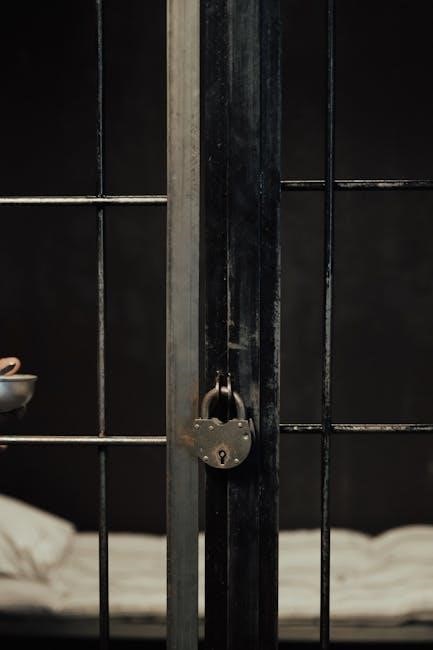Harry Potter and the Prisoner of Azkaban, the third book in J.K. Rowling’s series, marks a significant shift to a darker, more complex tone. Introduced are Sirius Black, a mysterious escaped prisoner, and the terrifying Dementors, while Harry uncovers shocking truths about his past. This instalment is pivotal, exploring themes of deception, hope, and loyalty, and is widely regarded as a fan favorite for its emotional depth and magical elements like the Patronus Charm and Marauder’s Map. Its release solidified the series’ impact on young readers and pop culture, leaving a lasting legacy;
Publication Background
Harry Potter and the Prisoner of Azkaban, written by J.K. Rowling, was first published on July 8, 1999, by Bloomsbury Publishing. This third installment marked a significant shift in the series, introducing a darker and more mature tone. The book quickly became a bestseller, topping charts worldwide and earning critical acclaim. Its success was further highlighted by winning the Whitbread Book Award, solidifying its place in the literary world. The story’s complex narrative and emotional depth resonated with readers, setting the stage for the rest of the series. The popularity of the book led to its widespread availability, including PDF formats, making it accessible to a global audience. Its publication remains a cornerstone in the Harry Potter saga.
Significance in the Series
Harry Potter and the Prisoner of Azkaban is a pivotal installment in the series, marking a darker and more mature shift in storytelling. It introduces key characters like Sirius Black and Remus Lupin, while deepening the mystery of Harry’s past. The book’s exploration of themes such as depression, hope, and loyalty resonated deeply with readers. Its success solidified the series’ global appeal, earning it the Whitbread Book Award and widespread acclaim. The story’s emotional depth and magical elements, like the Patronus Charm, set the tone for future books. This novel is often regarded as a fan favorite, showcasing Rowling’s ability to weave complex narratives and character development. Its influence on the series’ legacy is undeniable, making it a cornerstone of the Harry Potter saga.
Initial Reception
Harry Potter and the Prisoner of Azkaban received widespread acclaim upon its release in 1999. Critics praised its darker tone, complex characters, and emotional depth. The book debuted at number one on The New York Times bestseller list and won the Whitbread Book Award, solidifying its place in the series. Fans embraced the introduction of Sirius Black and the Patronus Charm, while the Marauder’s Map became a fan favorite. The story’s exploration of themes like depression and hope resonated deeply, marking a turning point in the series’ maturity. Its success further cemented Harry Potter’s global phenomenon status, with many considering it one of the best installments in the series.

Plot Summary
Harry Potter’s third year at Hogwarts unfolds with the escape of Sirius Black, a prisoner believed to threaten Harry. As dark secrets about Harry’s past emerge, he confronts Dementors, learns the Patronus Charm, and uncovers the truth about Black’s connection to his parents. The story intertwines friendship, loyalty, and the revelation of Black’s innocence, culminating in a climactic showdown that changes Harry’s understanding of his family and destiny. The introduction of magical elements like the Marauder’s Map and the Patronus Charm enriches the narrative, making it a pivotal and emotionally charged chapter in the series.
Harry’s Third Year
Harry’s third year at Hogwarts begins with the unsettling news of Sirius Black’s escape from Azkaban Prison. Believing Black is coming for him, Harry must navigate a year filled with uncertainty and danger. The Dementors, foul creatures that feed on human happiness, become a constant threat, forcing Harry to learn the Patronus Charm to defend himself. Alongside Ron and Hermione, Harry uncovers the truth about Black’s connection to his parents and his own past. The year is marked by emotional turmoil, newfound magical skills, and the revelation of loyal friendships. Harry’s journey through this year is pivotal, shaping his understanding of his destiny and the wizarding world.
The Escape of Sirius Black
The escape of Sirius Black from Azkaban Prison sets off a chain of events that dominate Harry’s third year. Black, believed to have betrayed Harry’s parents to Voldemort, is thought to be coming for Harry. His escape shocks the wizarding world, as Azkaban is considered impregnable. The Ministry of Magic and Hogwarts increase security, but Black’s motives remain unclear. Through his journey, Harry learns that Black is his father’s best friend and is innocent, having been wrongly accused. Black’s escape not only reveals hidden truths but also introduces Harry to a loyal ally and a deeper understanding of his family’s history. This plot twist is central to the story’s unfolding mystery and redemption.
The Truth About Harry’s Past
The truth about Harry’s past is unveiled when he learns that Sirius Black, believed to be his parents’ betrayer, is actually his father’s close friend. Through Remus Lupin and Black’s revelations, Harry discovers that Peter Pettigrew, a family friend, betrayed his parents to Voldemort. This shocks Harry, as he had trusted Pettigrew unknowingly. The truth rewrites Harry’s understanding of his parents and their relationships, revealing a loyal friendship between James, Sirius, and Remus. This revelation also explains Harry’s connection to Sirius, who becomes a protective figure in his life. The truth about his past brings Harry closer to his family’s legacy and helps him confront his identity, fostering themes of forgiveness, trust, and the complexity of human relationships.
The Climax and Resolution
The climax of Harry Potter and the Prisoner of Azkaban occurs when Harry, Ron, and Hermione confront Sirius Black and Peter Pettigrew. Harry learns the shocking truth: Sirius is innocent and was falsely accused of betraying his parents, while Pettigrew is the real traitor. In a tense showdown, Lupin transforms into a werewolf, and Pettigrew escapes. Sirius is finally exonerated, but the Dementors return, forcing Harry to use the Patronus Charm to save himself and Sirius. The resolution brings emotional closure as Harry bonds with Sirius, discovering a loyal family connection. Though Pettigrew flees, Harry gains hope and understanding of his parents’ past, strengthening his resolve for future challenges.

Themes
Themes of deception, forgiveness, depression, and hope dominate, alongside loyalty and friendship. The book explores complex emotions and redemption, delving into darker, emotionally charged narratives that resonate deeply.
Deception and Forgiveness
Deception and forgiveness are central themes in Harry Potter and the Prisoner of Azkaban. Harry discovers that Sirius Black, believed to have betrayed his parents, is actually his father’s close friend. The truth reveals Petter Pettigrew’s betrayal, uncovering a web of lies. Forgiveness emerges as Harry grapples with the complexities of adult relationships and loyalty. The novel highlights the redemptive power of understanding and mercy, as Harry learns to forgive and embrace the truth about his parents’ past. This theme underscores the emotional depth of the story, emphasizing the importance of uncovering secrets and finding redemption through forgiveness, which ultimately shapes Harry’s character and his ability to confront darkness.
Depression and Hope
Depression and hope intertwine poignantly in Harry Potter and the Prisoner of Azkaban. Harry faces intense emotional struggles, grappling with the Dementors’ soul-sucking presence, which embody clinical depression. His encounters with these creatures highlight the suffocating nature of despair. However, the novel offers hope through Harry’s resilience and the support of friends and mentors. The introduction of the Patronus Charm symbolizes the power of hope and happiness to combat darkness. Remus Lupin’s guidance further illuminates the importance of coping mechanisms and understanding. The interplay between depression and hope underscores the novel’s emotional depth, providing readers with a powerful narrative about perseverance and the light that can overcome even the darkest shadows.
Loyalty and Friendship
Loyalty and friendship are central themes in Harry Potter and the Prisoner of Azkaban. Harry’s bond with Ron and Hermione deepens as they stand by him through the turmoil surrounding Sirius Black. Their unwavering support highlights the strength of true friendship. Sirius Black’s loyalty to Harry’s parents and his subsequent protection of Harry further underscore the theme. Remus Lupin’s friendship with Sirius and his mentorship of Harry also exemplify loyalty. The Marauder’s Map, created by Sirius, Remus, and Peter, symbolizes the enduring ties of friendship. These relationships provide Harry with the emotional and magical support needed to navigate his challenges, reinforcing the idea that loyalty and friendship can overcome even the darkest obstacles.

Character Analysis
Harry, Sirius, Remus, and the Dementors are central to the story, each representing unique struggles and redemption. Their complex relationships and transformations drive the narrative forward.
Harry Potter
Harry Potter, in his third year at Hogwarts, faces unprecedented challenges as he uncovers the truth about Sirius Black, a man believed to have betrayed his parents to Voldemort. Initially fearing Black, Harry learns the shocking reality: Sirius is his father’s best friend and innocent. This revelation, alongside encounters with Dementors and the Patronus Charm, marks Harry’s growth from a frightened boy to a resilient hero. His journey is fraught with emotional turmoil, including feelings of isolation and anger, yet ultimately, he finds hope and strength through friendship and the truth about his past. This year is pivotal in shaping Harry’s understanding of loyalty, forgiveness, and his own destiny.

Sirius Black
Sirius Black, a pivotal character in Harry Potter and the Prisoner of Azkaban, is introduced as a mysterious and feared figure. Believed to have betrayed Harry’s parents to Voldemort, he escapes from Azkaban Prison, intensifying the story’s tension. However, Harry discovers the truth: Sirius is his father’s best friend and innocent of the crime. Wrongly accused and imprisoned for twelve years, Sirius’s story reveals themes of injustice and redemption. His deep connection to Harry and his tragic past add emotional depth to the narrative. Despite his hardships, Sirius embodies loyalty, love, and resilience, becoming a key figure in Harry’s understanding of his family and destiny. His presence highlights the complexity of truth and forgiveness in the wizarding world.
Remus Lupin
Remus Lupin, a Defense Against the Dark Arts teacher at Hogwarts, plays a crucial role in Harry’s third year. As a werewolf, Lupin faces societal prejudice, yet his kindness and talent earn him respect. His friendship with Sirius Black and Harry’s father, James Potter, ties him deeply to Harry’s past. Lupin’s mentorship helps Harry master the Patronus Charm, a vital skill against Dementors. Despite his struggles with his condition, Lupin remains loyal and compassionate, offering Harry guidance and support. His character highlights themes of acceptance and the challenges of living with a stigmatized identity, making him a beloved and relatable figure in the series. His interactions with Harry and Sirius are central to the story’s emotional journey.
Dementors
Dementors are the fearsome, soul-sucking creatures that guard Azkaban prison, feeding on human happiness and leaving victims in a state of despair. Their chilling presence causes depression and hopelessness, drawing energy from positive emotions. In Harry Potter and the Prisoner of Azkaban, Dementors are central to the plot, as they relentlessly pursue Sirius Black and threaten Harry. These dark beings are described as tall, shadowy figures with a paralyzing kiss that removes the soul. Harry learns to repel them using the Patronus Charm, a defensive spell requiring intense concentration and happiness. The Dementors symbolize the overwhelming nature of depression and the struggle to maintain hope in darkness, making them a haunting element in the story’s darker tone. Their presence underscores the emotional challenges Harry faces during his third year at Hogwarts. The creatures’ relentless pursuit adds tension, highlighting the dangers of unchecked despair and the importance of resilience. Through his encounters with Dementors, Harry grows stronger, mastering the Patronus Charm and confronting his inner fears. The Dementors’ role in the narrative illustrates the battle between light and darkness, a recurring theme in the series. Their impact on the characters and the story emphasizes the fragility of hope and the power of courage. The Dementors remain a memorable and terrifying aspect of the Harry Potter universe, embodying the horrors of emotional and psychological torment. Their influence extends beyond the plot, resonating with readers who have experienced similar struggles. The creatures’ presence in the book serves as a stark reminder of the consequences of allowing darkness to prevail, making them a pivotal element in the story’s exploration of mental health and resilience. The Dementors’ haunting nature ensures they remain an indelible part of the Harry Potter legacy, symbolizing the enduring fight against despair and the importance of hope. Their role in Harry’s journey underscores his growth and the lessons he learns about confronting fear and maintaining hope in the face of adversity. The Dementors’ significance in the story is undeniable, making them a key component of the book’s emotional and thematic depth. Their impact on Harry and the plot drives the narrative forward, illustrating the complexities of dealing with trauma and the power of inner strength. The Dementors’ presence in the book serves as a stark reminder of the enduring struggle between light and darkness, a central theme in the Harry Potter series. Through their relentless pursuit and the fear they inspire, the Dementors push Harry to confront his past and embrace his destiny. Their role in the story is both terrifying and transformative, leaving a lasting impression on readers and deepening the narrative’s emotional resonance. The Dementors’ influence extends beyond the plot, offering insights into the human condition and the universal struggle with mental health. Their presence in the book ensures that Harry’s journey is not only about magic but also about the resilience of the human spirit. The Dementors’ haunting nature and the lessons they teach Harry make them a crucial element in the story’s exploration of hope, despair, and the power of courage. Their impact on the narrative and its themes solidifies their place as one of the most memorable and significant creatures in the Harry Potter universe. The Dementors’ role in Harry Potter and the Prisoner of Azkaban is a testament to the book’s ability to weave magical elements with profound emotional depth, creating a story that resonates deeply with readers. The creatures’ presence serves as a reminder of the ongoing battle between light and darkness, a theme that continues to unfold throughout the series. The Dementors’ relentless pursuit of Harry and Sirius Black drives the plot forward, while their symbolic representation of depression and despair adds layers of complexity to the narrative. Through his encounters with the Dementors, Harry learns valuable lessons about hope, resilience, and the importance of confronting fear. The Dementors’ significance in the story is further highlighted by their impact on the characters and the overall tone of the book, making them a memorable and haunting element of the Harry Potter world. The creatures’ presence in the narrative ensures that the themes of mental health and hope are explored in a way that is both poignant and powerful. The Dementors’ role in Harry’s journey is both challenging and transformative, shaping his understanding of himself and his place in the wizarding world. Their influence extends beyond the plot, offering readers a deeper understanding of the complexities of dealing with trauma and the enduring power of hope. The Dementors’ haunting presence in the book serves as a stark reminder of the dangers of despair and the importance of maintaining hope, even in the darkest of times. Through their relentless pursuit and the fear they inspire, the Dementors push Harry to confront his past and embrace his destiny, making them a crucial element in his growth and development as a character. The Dementors’ significance in the story is undeniable, as they embody the universal struggle with mental health and the enduring power of resilience. Their presence in the book ensures that the themes of hope and despair are explored in a way that is both haunting and profound, leaving a lasting impact on readers. The Dementors’ role in Harry Potter and the Prisoner of Azkaban is a testament to the book’s ability to weave magical elements with emotional depth, creating a narrative that continues to resonate with readers of all ages. The creatures’ relentless pursuit and the fear they inspire drive the plot forward, while their symbolic representation of depression and despair adds layers of complexity to the story. Through his encounters with the Dementors, Harry learns valuable lessons about hope, resilience, and the importance of confronting fear, making them a pivotal element in his journey. The Dementors’ significance in the story is further highlighted by their impact on the characters and the overall tone of the book, ensuring that they remain a memorable and haunting part of the Harry Potter universe. The creatures’ presence in the narrative serves as a reminder of the ongoing battle between light and darkness, a central theme in the series. The Dementors’ relentless pursuit of Harry and Sirius Black drives the plot forward, while their symbolic representation of depression and despair adds layers of complexity to the narrative. Through his encounters with the Dementors, Harry learns valuable lessons about hope, resilience, and the importance of confronting fear. The Dementors’ significance in the story is further highlighted by their impact on the characters and the overall tone of the book, making them a memorable and haunting element of the Harry Potter world. The creatures’ presence in the narrative ensures that the themes of mental health and hope are explored in a way that is both poignant and powerful. The Dementors’ role in Harry’s journey is both challenging and transformative, shaping his understanding of himself and his place in the wizarding world. Their influence extends beyond the plot, offering readers a deeper understanding of the complexities of dealing with trauma and the enduring power of hope. The Dementors’ haunting presence in the book serves as a stark reminder of the dangers of despair and the importance of maintaining hope, even in the darkest of times. Through their relentless pursuit and the fear they inspire, the Dementors push Harry to confront his past and embrace his destiny, making them a crucial element in his growth and development as a character. The Dementors’ significance in the story is undeniable, as they embody the universal struggle with mental health and the enduring power of resilience. Their presence in the book ensures that the themes of hope and despair are explored in a way that is both haunting and profound, leaving a lasting impact on readers. The Dementors’ role in Harry Potter and the Prisoner of Azkaban is a testament to the book’s ability to weave magical elements with emotional depth, creating a narrative that continues to resonate with readers of all ages. The creatures’ relentless pursuit and the fear they inspire drive the plot forward, while their symbolic representation of depression and despair adds layers of complexity to the story. Through his encounters with the Dementors, Harry learns valuable lessons about hope, resilience, and the importance of confronting fear, making them a pivotal element in his journey. The Dementors’ significance in the story is further highlighted by their impact on the characters and the overall tone of the book, ensuring that

Magical Elements
The Patronus Charm, Dementors, and Marauder’s Map are central magical elements in Harry Potter and the Prisoner of Azkaban, showcasing defensive magic, soul-sucking creatures, and magical navigation tools that enhance the story’s depth and mystery.
Dementors are the terrifying guards of Azkaban prison, feeding on human happiness and leaving a trail of cold, despair, and darkness. Their presence causes overwhelming sadness and fear, affecting even Harry, who hears his mother’s screams when they near him. These dark creatures are drawn to negative emotions, making them a constant threat to Harry’s well-being. The Dementors’ ability to suck out souls through the “Dementor’s Kiss” adds to their horrifying nature. Harry learns to defend against them using the Patronus Charm, a complex spell requiring intense focus and happiness. The Dementors symbolize depression and hopelessness, making them central to the book’s darker themes and Harry’s emotional journey.
Patronus Charm
The Patronus Charm, a powerful defensive spell, plays a central role in Harry Potter and the Prisoner of Azkaban. Taught to Harry by Professor Lupin, it conjures a silvery light to repel Dementors. The spell requires concentration, a happy memory, and the incantation “Expecto Patronum.” Harry’s Patronus takes the form of a stag, symbolizing his father’s Animagus form. The charm is crucial in protecting Harry from the soul-sucking Dementors and represents his growing magical prowess. Mastery of the Patronus Charm is a significant milestone, showcasing Harry’s ability to confront darkness and despair. This spell becomes a key tool in his arsenal, emphasizing the importance of hope and resilience in the face of overwhelming adversity.
Marauder’s Map
The Marauder’s Map is a magical chart created by James Potter, Sirius Black, Remus Lupin, and Peter Pettigrew during their Hogwarts years. It reveals the real-time location of everyone within Hogwarts Castle and its grounds, making it an invaluable tool for navigation and secrecy. In Harry Potter and the Prisoner of Azkaban, the map plays a pivotal role in uncovering hidden passages and avoiding detection. Its interactive nature and precise detailing make it a testament to the Marauders’ ingenuity. The map becomes a key asset for Harry, helping him uncover the truth about Sirius Black and navigate the complexities of his third year. Its legacy endures, symbolizing friendship, cleverness, and the magic of Hogwarts.

Book vs. Movie Adaptation
The film adaptation of Harry Potter and the Prisoner of Azkaban captures the book’s essence but omits key subplots, like Marauders’ backstory and the Shrieking Shack scenes, for brevity. Director Alfonso Cuarón brought a darker, more atmospheric tone, enhancing the story’s emotional depth. While the movie stays true to major plot points, fans often note the absence of certain details that enrich the narrative in the book. The adaptation is praised for its visual brilliance and faithful portrayal of characters, making it a standout in the series.
Differences Between Book and Film
The film adaptation of Harry Potter and the Prisoner of Azkaban made significant changes to the original story. Key subplots, such as the Marauders’ backstory and the Shrieking Shack scene, were omitted. The movie also simplified the time-travel sequence and reduced the role of certain characters, like Cornelius Fudge. Additionally, the Dementors’ presence was less prominent in the film compared to the book. While the movie captured the overall tone and emotional depth, it streamlined the narrative, focusing on Harry’s journey and the revelation about Sirius Black. These changes, while necessary for runtime, left out details that enriched the story in the book, particularly for fans who appreciated the deeper lore and character development.
Reception of the Movie
The film adaptation of Harry Potter and the Prisoner of Azkaban received widespread acclaim for its darker tone and emotional depth. Critics praised director Alfonso Cuarón’s vision, noting his ability to balance the story’s complexity with visual brilliance. The movie holds a high rating on platforms like Rotten Tomatoes, with many highlighting its faithful adaptation of the book’s essence. Fans appreciated the introduction of Sirius Black and the Dementors, which added layers to the narrative. However, some felt the pacing was rushed, and certain characters were underdeveloped. Despite this, the film is often regarded as one of the best in the series, celebrated for its thematic richness and the performances of the cast, particularly Gary Oldman as Sirius Black.
Changes in Character Portrayals
The film adaptation of Harry Potter and the Prisoner of Azkaban introduced notable changes in character portrayals. Richard Harris’s passing led to the recasting of Dumbledore, with Michael Gambon taking over, bringing a slightly different interpretation. Sirius Black, played by Gary Oldman, was well-received for his complexity and depth. However, some fans felt that Remus Lupin’s character was underdeveloped in the film compared to the book. The Dementors were also portrayed as more ghostly and menacing, aligning with the movie’s darker aesthetic. These changes, while faithful to the story’s essence, offered a fresh visual and emotional perspective, enhancing the narrative’s impact for audiences new to the series.

Cultural Impact
Harry Potter and the Prisoner of Azkaban has left a lasting legacy in pop culture, sparking fan theories and inspiring countless discussions. Its themes resonate deeply with young readers, fostering emotional connections and a sense of belonging. The book’s darker tone and complex characters have influenced literature and film, solidifying its place as a cultural phenomenon. Celebrations like its 20th-anniversary return to theaters highlight its enduring appeal, making it a timeless story that continues to captivate audiences worldwide.
Fan Reactions and Theories
Fans of Harry Potter and the Prisoner of Azkaban have long been captivated by its intricate plot and emotional depth. The escape of Sirius Black and Harry’s connection to him sparked countless theories about his innocence and true identity. Many fans initially believed Black was a villain, only to be surprised by the truth. The introduction of Dementors and the Patronus Charm also fueled fan discussions, with readers sharing their own interpretations of these magical elements. Additionally, the time-turner subplot inspired debates about time travel and its implications. The book’s climax, particularly the revelation about Peter Pettigrew, remains a favorite moment for many, showcasing Rowling’s masterful storytelling. Fan art, fan fiction, and online forums continue to celebrate this beloved instalment, proving its lasting impact on the Harry Potter community.
Legacy in Pop Culture
Harry Potter and the Prisoner of Azkaban has left an indelible mark on pop culture, inspiring countless fan creations, from art to cosplay. The iconic Dementors and Sirius Black’s story arc have become cultural references, symbolizing depression and redemption. The film adaptation, directed by Alfonso Cuarón, is often praised for its visual and emotional depth, influencing other fantasy films. The Marauder’s Map and Patronus Charm are beloved elements, featured in merchandise and video games. The book’s 20th anniversary celebrations highlighted its enduring appeal, with fans worldwide revisiting its themes and characters. Its legacy extends beyond literature, shaping modern storytelling and cementing its place as a cultural phenomenon, continues to inspire new generations of readers and creators alike. Its impact remains unparalleled in the wizarding world and beyond.
Influence on Young Readers
Harry Potter and the Prisoner of Azkaban has profoundly impacted young readers by exploring complex emotions and themes such as depression, hope, and loyalty. The introduction of Sirius Black and Remus Lupin teaches the importance of understanding and compassion, challenging stereotypes. The book’s darker tone resonates with adolescents navigating their own struggles, offering solace and resilience. Magical elements like the Patronus Charm and Marauder’s Map inspire creativity and curiosity. The story’s emphasis on friendship and standing up against injustice fosters empathy and courage. Its relatable characters and real-world parallels encourage young readers to reflect on their own lives, making it a cornerstone of many childhoods and a catalyst for a lifelong love of reading and critical thinking.

Online Discussions and Forums

Impact and Resources for Readers
The Harry Potter and the Prisoner of Azkaban PDF remains a popular resource, offering fans a convenient way to revisit the story. Study guides and summaries provide deeper insights, while online forums foster vibrant discussions among enthusiasts. The book’s themes and characters continue to inspire, making it a timeless favorite in the series.

No Responses